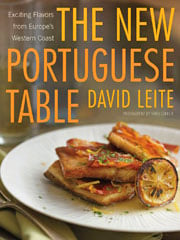
When I visited A Bolota, a lovely restaurant perched on the sweeping plains of the eastern Alentejo, this dip, called patê de azeitonas verdes, was brought to our table. As I nattered away with friends, I dipped, spread, and nibbled, until I realized I alone had eaten all of it. Later, when I became friendly with the cook, Ilda Vinagre, I watched her make it and was flummoxed when she whipped up its silky base: milk “mayonnaise”—whole milk whirred into a smooth consistency with the addition of vegetable oil. I serve this as a dip with a platter of crudités, alongside crackers or bread, or, sometimes, as a topping for grilled fish.–David Leite
Atenção [Editor’s Note: That means “attention”)
Don’t make this in a food processor. The bowls of most processors are too large to allow the scant amount of ingredients to whip up to the right consistency. A small narrow blender or a mini chop or handheld blender works best.

Portuguese Green Olive Dip
Equipment
- A small mini chop or hand blender
Ingredients
- 1/3 cup whole milk, plus more if needed
- 6 oil-packed anchovy filets
- 1 small garlic clove
- Leaves and tender stems of 6 cilantro sprigs
- Pinch of freshly ground white pepper
- 3/4 cup vegetable oil
- 2/3 cup pitted green olives such as Manzanilla, rinsed quickly if particularly salty, roughly chopped
Instructions
- In a blender, pulse to combine the 1/3 cup milk, anchovies, garlic, 2/3 of the cilantro, and the pepper.
- With the motor running, pour the oil in what the Portuguese call a fio, or fine thread. Keep whirring until the oil is incorporated and the mixture thickens, 30 seconds to 1 1/2 minutes, depending on your equipment.
- Scrape the dip into a bowl and stir in the olives. Mince the remaining cilantro, sprinkle on top, and serve. If the dip thickens, you can always simply stir in a tablespoon or two of milk.

Nutrition
Nutrition information is automatically calculated, so should only be used as an approximation.











I noticed that this recipe differs in the others that there is no mention of lemon juice. I tried two batches, one in a mini chop, and one with a wand blender. The one with the wand came out a little thicker, but nowhere near as thick as I think it should be. I wanted to make some for a party tomorrow, and thought about making a double batch in a standard blender. Any hints?
P.S. My wife bought me your book for my birthday. I love it. Obrigado!
Steve, thanks for the kind words!
There’s no lemon juice in this version because the anchovies add the oomph to thicken it. I’d suggest using the wand blender (not doubling the amount) and going as long as you need to thicken it. When I tested it, I used all types of handheld blenders and tried to find an average time. Yours might require longer whizzing. But I assure, it will thicken! Also, when the olives are mixed in, the brine in them will also thicken it—which is why in the second printing of the book, we added the instructions to thin the mixture with a bit of milk if it gets too thick.
This is a delicious spread, but strongly flavored– I only used 6 anchovies and that was PLENTY. The milk-oil emulsion makes for a light dip that beautifully conveys the garlic-anchovy-olive flavors without the usual heaviness associated with a cheese-laden spread. Tasty and perfect with cocktails and crusty french bread. If you have trouble forming an emulsion, you have to pour in the oil slowly– the stream of oil should be about half as thick as a pencil. I had no trouble making this thicken in an ordinary blender.
Thanks, Pielove! That’s an incredibly helpful description for streaming the oil.
Sounds delicious…any problem using salt-packed anchovies, if they’re well-rinsed?
Kelly, the oil in oil-packed anchovies add a more body and anchovy taste to the dip. You can certainly try the salt-packed version, but you might need to add a dribble more oil and process it a bit longer.